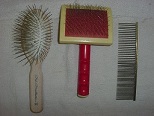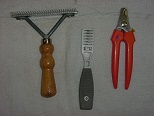
Grooming Tips
Grooming is an essential part of keeping your dog healthy and happy. Not to mention looking great! Here are the basic steps to help maintain a beautiful, healthy coat. First, you'll need the following equipment:


It's important to remember to never brush a dry coat. There are some very good grooming sprays or you can use water. The coat should be lightly misted and not dripping wet. This will prevent coat breakage.
Starting at the rear, lower leg, lift the hair and brush with the pin brush to remove loose hair. Then go over the same area with the slicker brush to remove small mats. Be sure not to use too much pressure or brush in the same area too long with the slicker to prevent brush burn. Work your way up the leg in layers to be sure to get through the hair. This way, you brush all the hair and not just the outer coat. When you get to the upper leg, be especially sure to brush this area thoroughly. The hair on the collies rear tends to be somewhat dry so a good grooming spray will help keep this area under control. Don't forget to brush inside the leg as mats form here very readily.
Working your way to the front of the dog in this way will assure you get all the dead and loose undercoat removed. Another area prone to matting is the armpit. To brush here, pick up the dogs foot and hold the leg out in front of him. This is a sensitive area, so brush carefully and don't be surprised if he struggles a bit. If you find small mats here, they can usually be brushed out. But if they are large, they may have to be shaved out. Most groomers will do this for a small fee. Then, once they're shaved, you can keep them from forming again by regular brushing.
The area around the neck is typically very thick and will take the most time to brush. This is done in the same fashion as the rest of the dog. In layers, starting at the back of the neck, working around the front, and then around the other side.
The head is done with a fine/medium tooth comb. Pay particular attention to the fine hair behind the ears. Small mats here can be combed out but again if they are large and close to the skin, have them shaved out. NEVER, EVER take a scissor to mats behind the ears on your dog! It is extremely easy to cut the skin. If need be, there is a tool called a mat breaker which works well here, but it, too, is sharp and must be used with caution. Comb the top of the head, and the cheeks. They shed here, too! Whisker removal is purely a matter of choice. You can use a small, blunt tipped pair of scissors for this.
Moisten a cotton ball and clean the ear only as far as you can see into the ear.
To trim toenails, I find a pliers type trimmer to work the best. To avoid cutting the quick in the nail, take small bits off the nail. When you see a small, black dot in the center of the nail, you've gone far enough. White nails are easier as you can see the vein through the nail. If you do get the quick, take a dab of styptic and hold it on the end of the nail for a few seconds. This will stop the bleeding. If you don't have styptic, corn starch or flour will do this also. Check the feet for any injuries or burrs stuck in the hair between the pads. Being very careful, you can trim the hair even with the bottom of the foot. To trim the foot, brush the hair down, and trim it around the edge. Then brush it up, and trim it even with the top.
Brushing is not only an opportunity to keep your dog looking good. It's also a good opportunity to check his skin for anything out of the ordinary, such as hotspots. Hotspots are moist areas that usually occur when the dog continually chews on a particular spot. Sometimes this is caused by flea bites, or not rinsing well enough during a bath. They can also occur under un-noticed mats. To prevent them, when you bathe your dog, rinse well. When you think you've rinsed enough, rinse for 15 to 20 minutes more.
Use a good flea preventative, also. Many dogs are allergic to flea bites and start chewing these areas to relieve the itching.
Undercoat removal
The undercoat is the thick, wooly hair that protects your dog from heat and cold. In the summer, it acts as an insulator against the heat, in the winter, against the cold. Cutting the hair in the summer will not make your dog cooler. Removing the loose undercoat will.
Indoor collies typically shed year-round. But they will shed more in spring and fall. Contrary to popular belief, this is due to the amount of light, not the change in temperature. This is why indoor dogs shed continually. There is constant light. Use the undercoat rake to remove the loose hair. There are specific areas where the rake will be most useful. They are the rear, directly in front of the back leg, right behind the front leg, and around the neck. Remember, the idea is to remove the loose hair. Do not put too much pressure on the rake.
Bathing
You will get wet, too! Have lots of towels!
Once you have the dog completely brushed and there are no mats, you are ready for the bath. It's important to have the dogs mat free as bathing will tighten any mats and make them nearly impossible to remove. Start by wetting the dog completely. Start at the head. In this way, when the dog shakes you won't get completely soaked. If you have trouble getting the coat wet, you can put a little shampoo on the dog and then wetting. This is particularly useful for the tail. Once you have the dog shampooed, take the pin brush and work the shampoo into the coat. At this point, you can also put conditioner on the dog. Or you can rinse the shampoo out and use the same steps for conditioning. I like to use a leave in conditioner on my own dogs.
When you are sure the dog is clean, start to rinse. Start at the head and work your way back. RINSE WELL! Shampoo residue left on the dog can cause skin irritations, including hot spots. When the water runs clear off the dog, you have rinsed enough. Towel dry. To dry the dog, you can use a hair dryer on a low setting, or there are several animal dryers available. Using your pin brush, dry in sections starting at the rear. Lift the hair and dry, always moving the dryer to avoid burning the skin. Dry the dog completely.
Pay particular attention to the inside legs and the under side. Dampness in these areas can also cause skin irritation.
Whew! Almost done! You've brushed, you've bathed, you've brushed again. You've trimmed toenails and feet. You've had some great bonding time. Because your dog is a collie, he's behaved impeccably during all this. Take him to the store and buy him a favorite toy. He's deserved it.
A collie should be professionally groomed at least four times a year. Better still, every eight weeks. Brush at home at least twice weekly.
Remember, the more vigilant you are about brushing, the less work it is.
And last but not least, enjoy your new companion...